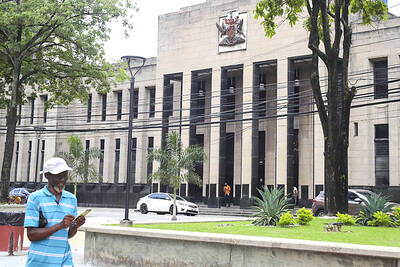Thousands of people on Sunday night massed outside the Moulin Rouge cabaret for a fireworks and French can-can extravaganza to mark the 130th anniversary of the storied Montmartre institution.
Police blocked off the boulevard for the event, which began with music and a light show projected onto the iconic red windmill, recounting the venue’s Belle Epoque origins.
A sole dancer then appeared on the roof, braving the autumn chill in one of the caberet’s skimpy sequined costumes — although she was not topless, presumably a nod to the families in the crowd.

Photo: AFP
Then, as fireworks boomed overhead — red, naturally, later mixed with whites and blues — around 50 long-legged dancers wearing the same colors emerged to perform their famous can-can.
Yiftah Bar-Akiva, an Israeli who has lived in Paris for 11 years, was sipping champagne from a flute glass with friends who came for the party.
“It’s as mythical as the Eiffel Tower, it’s like a piece of history of the Belle Epoque,” he said.
“I don’t think it’s disrespectful of women, I think it’s still art,” he said. “It’s not like it’s a peepshow.”
Joanna Cavarzan traveled from her home near the city of Chartres, not far from Paris, with a friend, Joe McGinty, who was visiting from Toronto.
“I’ve never been inside, and I was hoping to see a little bit what it was like,” Cavarzan said.
Yet like many in the crowd, she could hardly see the dancers — no stage had been set up on the boulevard for their show. Opened in 1889 — the same year as the Eiffel Tower was completed — the Moulin Rouge has become a must-see for millions of tourists to the French capital, even if only from the outside.
The two nightly shows, two hours each, are almost always sold out seven nights a week, 365 nights a year, with tourists and locals attending in roughly even numbers.
The cabaret has also become a touchstone in popular culture, not only with Baz Luhrmann’s 2001 hit film, but in 1952 with John Huston’s version starring Zsa Zsa Gabor.

IDENTITY: A sex extortion scandal involving Thai monks has deeply shaken public trust in the clergy, with 11 monks implicated in financial misconduct Reverence for the saffron-robed Buddhist monkhood is deeply woven into Thai society, but a sex extortion scandal has besmirched the clergy and left the devout questioning their faith. Thai police this week arrested a woman accused of bedding at least 11 monks in breach of their vows of celibacy, before blackmailing them with thousands of secretly taken photos of their trysts. The monks are said to have paid nearly US$12 million, funneled out of their monasteries, funded by donations from laypeople hoping to increase their merit and prospects for reincarnation. The scandal provoked outrage over hypocrisy in the monkhood, concern that their status

The United States Federal Communications Commission said on Wednesday it plans to adopt rules to bar companies from connecting undersea submarine communication cables to the US that include Chinese technology or equipment. “We have seen submarine cable infrastructure threatened in recent years by foreign adversaries, like China,” FCC Chair Brendan Carr said in a statement. “We are therefore taking action here to guard our submarine cables against foreign adversary ownership, and access as well as cyber and physical threats.” The United States has for years expressed concerns about China’s role in handling network traffic and the potential for espionage. The U.S. has

A disillusioned Japanese electorate feeling the economic pinch goes to the polls today, as a right-wing party promoting a “Japanese first” agenda gains popularity, with fears over foreigners becoming a major election issue. Birthed on YouTube during the COVID-19 pandemic, spreading conspiracy theories about vaccinations and a cabal of global elites, the Sanseito Party has widened its appeal ahead of today’s upper house vote — railing against immigration and dragging rhetoric that was once confined to Japan’s political fringes into the mainstream. Polls show the party might only secure 10 to 15 of the 125 seats up for grabs, but it is

Trinidad and Tobago declared a new state of emergency on Friday after authorities accused a criminal network operating in prisons across the country of plotting to kill key government officials and attack public institutions. It is the second state of emergency to be declared in the twin-island republic in a matter of months. In December last year, authorities took similar action, citing concerns about gang violence. That state of emergency lasted until mid-April. Police said that smuggled cellphones enabled those involved in the plot to exchange encrypted messages. Months of intelligence gathering led investigators to believe the targets included senior police officers,